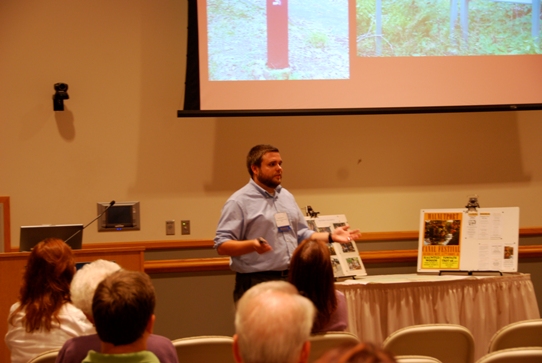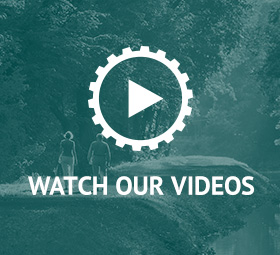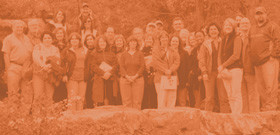The D&L Blog

Written By Silas Chamberlin
On September 30 and October 1, the Delaware & Lehigh National Heritage Corridor and the Wildlands Conservancy held the first Lehigh Valley Trails Summit at DeSales University in Center Valley. In past years, the Pennsylvania Recreation & Parks Society has collaborated with the Department of Conservation and Natural Resources to hold a statewide conference. This is the first year that a series of regional conferences replaced the statewide conference, and, by all accounts, our regional conference was a success. We cast an intentionally broad net when inviting panel participants and promoting the conference. As a result, we had a variety of groups represented: government officials, trail engineers, industry folks, volunteers, trail advocates, people interested in economic development and planning, and, of course, trail users.
The first day of the conference featured a keynote address from Dan Rice, President and CEO of the Ohio & Erie Canalway Coalition, a national heritage area that works on the development of a 101-mile towpath trail. Dan spoke to the group about creating regional partnerships to forward the related goals of environmental protection, historic resource preservation, economic development, and trail building. After the keynote address, a plenary session provided an overview of the Lehigh Valley trail network and ongoing issues affecting its development and connections. Mike Kaiser, executive director of the Lehigh Valley Planning Commission, spoke about efforts to use planning and zoning to foster trail development, including innovative zoning requirements that protect the Appalachian Trail. Other panelists spoke about the D&L Trail, Trexler Nature Preserve’s trails, and the proposed PA Highlands Trail.
After this session, participants broke into smaller groups for panels on more specific topics. A conference room was devoted to each of three themes: health and recreation; planning and design; and building and maintaining. An impressive variety of topics were covered. David Kahley of the Progress Fund spoke about using trails to drive economic development. Marilyn and Buddy Kaul of the Walnutport Canal Association and Donna Boone of the D&L’s Landmark Towns spoke about using community events and marketing to get people off the trail or towpath and into town. Meanwhile, for the more technically inclined, there were panels on environmental permitting, using GPS and GIS for trail building, ADA requirements, and building sustainable trails. A personal favorite of mine was Greg Weitzel’s (City of Allentown Parks & Recreation Director) succinct presentation, which came at the end of a lengthy panel session already running a bit over its allotted time. Greg gave a humorous but passionate commentary on the childhood obesity epidemic, the importance of trail and biking networks for urban commuters, and the need for reliable funding for recreation, open space, and infrastructure.
An added benefit of the conference was the presence of the ExplorePATrails.com team. DeSales provided a dedicated smart-room for a digital mapping workshop. Kent Taylor and Shane Hoover—the DCNR staff members behind the effort—sat down with anyone interested and helped them enter their trail’s information into the online database. For some of us, GIS, GPS, digital mapping, and the prospect of handling them all yourself can seem a bit daunting. This resource is intended to make the process a little easier. The website also provides a new way for trails organizations to promote their trail online with photos, maps, and trail descriptions—a capacity that some smaller organizations may not otherwise have. I was already familiar with the site, but I sat down with Shane who walked me through its new layout and helped brainstorm some ways the D&L could improve our online mapping. There were very few moments when the mapping room was empty, and it is great to see people taking advantage of this new resource.
After a full day of sessions, the Lehigh Valley’s trails community went home pooped and tried to rest up for day two. Unfortunately, that night we experienced record rainfalls (8” in Allentown!), which made getting back to DeSales a real problem. Those of us who braved the flooded roadways enjoyed a morning slate full of more interesting presentations. Diane Kripas and Lorne Possinger of DCNR talked about the state’s newest outdoor recreation plan, Pennsylvania Outdoors: The Keystone for Healthy Living, and the research behind its recommendations. Andy Strauss gave an introduction to establishing land ownership and key terms. Unfortunately, I only caught the end of this presentation, so I still don’t know what a “quit claim” is…
The only problem with this panel line up was agonizing over which panel to attend and which to regretfully skip. The afternoon of the second day was devoted to field workshops, so we could see some of these ideas about trail development put to practice. Unfortunately, one of the sites—the D&L Trail Tenders’ native plant garden on Sand Island—was underwater due to the rain, so participants chose between a trip to Trexler Nature Preserve or Lehigh Gap Nature Center. Once again, not an easy choice! Both sites provide models for cultivating partnerships between the state, the county, a local non-profit, and a volunteer base to make real progress on conservation and restoration projects and the development of trail networks. The rain held off for the tours, and they went very well.
Returning to DeSales after two long days of talking trails, we could sense a renewed sense of enthusiasm that always emerges after venting about your problems and brainstorming solutions with like-minded people. These are tough times for anyone relying on government funding, municipal support, or private donations. Trail organizations are especially susceptible because funding for recreation and open space are some of the first areas to experience cuts during times of budgetary belt tightening. This conference made clear, however, that there remains good work to be done, regardless of funding. Indeed, by pooling our ideas and resources and seeking out collaborative projects and opportunities, the trail community may emerge from this dubious economic period much stronger than ever before. The Lehigh Valley Trails Summit was a first step in that direction.
Many of the presentations from the 2010 Lehigh Valley Trails Summit are available for download from the D&L’s website.















